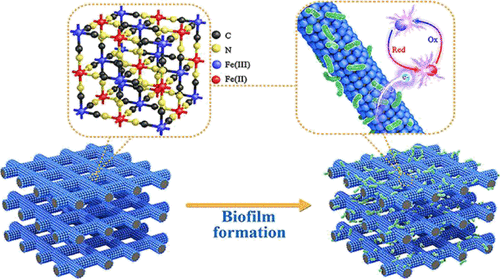当前位置:
X-MOL 学术
›
ACS Sustain. Chem. Eng.
›
论文详情
Our official English website, www.x-mol.net, welcomes your
feedback! (Note: you will need to create a separate account there.)
Artificial Electron Mediator with Nanocubic Architecture Highly Promotes Microbial Electrosynthesis from Carbon Dioxide
ACS Sustainable Chemistry & Engineering ( IF 7.1 ) Pub Date : 2020-03-25 , DOI: 10.1021/acssuschemeng.0c01276 Shihao Tian 1, 2 , Xiaoyue Yao 1, 3 , Tian-Shun Song 1, 2, 4, 5 , Zhenyu Chu 1, 3 , Jingjing Xie 1, 2, 4, 6 , Wanqin Jin 1, 3
ACS Sustainable Chemistry & Engineering ( IF 7.1 ) Pub Date : 2020-03-25 , DOI: 10.1021/acssuschemeng.0c01276 Shihao Tian 1, 2 , Xiaoyue Yao 1, 3 , Tian-Shun Song 1, 2, 4, 5 , Zhenyu Chu 1, 3 , Jingjing Xie 1, 2, 4, 6 , Wanqin Jin 1, 3
Affiliation

|
Microbial electrosynthesis (MES) is an emerging strategy for converting electrical energy into chemical energy. Many efforts have been made toward the enhancement of cathode-microorganism interactions and electron transfer by modifying cathodic materials; however, high electrochemical activity and good biocompatibility have often not been available at the same time in previously reported materials. Here, we deliver a novel MES bioreactor by designing a well-defined Prussian blue nanocube-modified carbon felt (PBNC-CF) as an artificial electron mediator-decorated cathode for organic molecule production from a CO2 source. Because of the rapid electronic transition between Fe2+ to Fe3+ atoms in a unit cell, PBNCs significantly improve the electrochemical activity of the cathode by dramatically increasing the electron supply to electroautotrophic microorganisms. This modification also enhances the biocatalytic activity by regulating the composition of microbial community with the accumulation of acetogens such as Acetobacterium and the reduction of the electron-transferring bacterium, Arcobacter. Furthermore, the hydrophilicity and positive charge of PBNCs improve cathodic biocompatibility and are conducive to the growth of biofilms on the electrode surface and internal fibers. This strategy provides a new direction for MES electrode modification, showing that the development of an artificial electron mediator-based cathode is significantly important to improve MES efficiency.
中文翻译:

具有纳米立方结构的人工电子介体高度促进了二氧化碳的微生物电合成
微生物电合成(MES)是一种将电能转换为化学能的新兴策略。通过改性阴极材料,为增强阴极-微生物相互作用和电子转移做出了许多努力。然而,在以前报道的材料中常常不能同时获得高电化学活性和良好的生物相容性。在这里,我们通过设计明确定义的普鲁士蓝纳米立方体改性碳毡(PBNC-CF)作为人造电子介体修饰的阴极,以从CO 2来源生产有机分子,来提供新型的MES生物反应器。由于Fe 2+到Fe 3+之间的快速电子跃迁PBNC原子是一个基本单元中的原子,通过显着增加对自养生物的电子供应,可显着改善阴极的电化学活性。该变形例也通过调节微生物群落的组合物与产乙酸菌如的积累提高了生物催化活性醋酸杆菌和电子转移细菌的减少,弓形杆菌。此外,PBNCs的亲水性和正电荷可改善阴极生物相容性,并有助于电极表面和内部纤维上生物膜的生长。该策略为MES电极的改进提供了新的方向,表明基于人工电子介体的阴极的开发对提高MES效率非常重要。
更新日期:2020-03-25
中文翻译:

具有纳米立方结构的人工电子介体高度促进了二氧化碳的微生物电合成
微生物电合成(MES)是一种将电能转换为化学能的新兴策略。通过改性阴极材料,为增强阴极-微生物相互作用和电子转移做出了许多努力。然而,在以前报道的材料中常常不能同时获得高电化学活性和良好的生物相容性。在这里,我们通过设计明确定义的普鲁士蓝纳米立方体改性碳毡(PBNC-CF)作为人造电子介体修饰的阴极,以从CO 2来源生产有机分子,来提供新型的MES生物反应器。由于Fe 2+到Fe 3+之间的快速电子跃迁PBNC原子是一个基本单元中的原子,通过显着增加对自养生物的电子供应,可显着改善阴极的电化学活性。该变形例也通过调节微生物群落的组合物与产乙酸菌如的积累提高了生物催化活性醋酸杆菌和电子转移细菌的减少,弓形杆菌。此外,PBNCs的亲水性和正电荷可改善阴极生物相容性,并有助于电极表面和内部纤维上生物膜的生长。该策略为MES电极的改进提供了新的方向,表明基于人工电子介体的阴极的开发对提高MES效率非常重要。











































 京公网安备 11010802027423号
京公网安备 11010802027423号